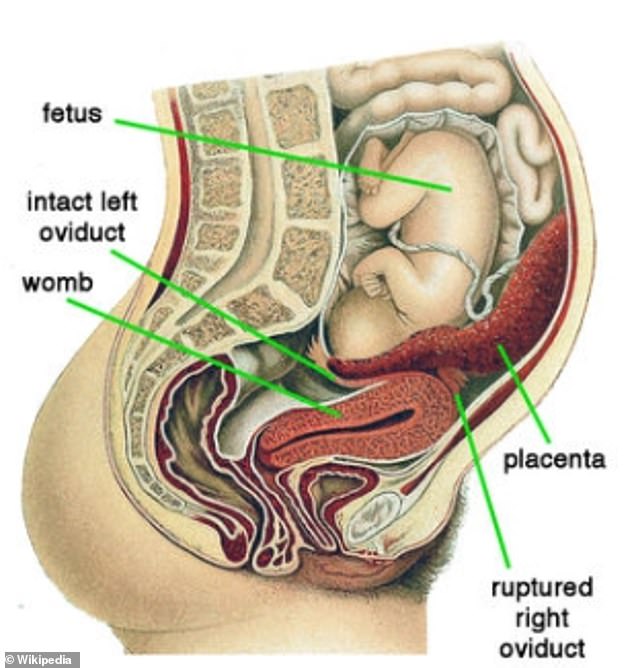Woman, 37, who went to doctors complaining of stomach cramps is told there is a baby growing in her BOWEL and she’s 23 weeks pregnant – in rare medical phenomenon
A woman who suffered from extreme bloating was shocked to discover she was 23 weeks pregnant and had a fetus growing in her intestines.
The woman, 37, went to doctors complaining of pain in her abdomen that lasted for ten days – and of bloating that had gradually gotten worse.
Scans showed a 'normally shaped' fetus growing in her abdominal cavity – the space between the stomach and intestines.
This medical phenomenon is known as an ectopic pregnancy and is almost always fatal to the child. But doctors were able to deliver the child at 29 weeks, and within three months both mother and child were discharged.
Above is a bird's eye view scan of her abdomen. The asterisk above indicates the empty uterus, while the arrow indicates the growing fetus
The matter came to light in the New England Journal of Medicine.
Doctors diagnosed her with an abdominal pregnancy, a type of ectopic pregnancy – or pregnancy outside the uterus – that occurs in the abdomen.
The baby was in the peritoneal cavity, or the area in which the vital organs are located, with the placenta attached to the top of the pelvis.
Doctors said these pregnancies are very rare but possible if a fetus accidentally implants in the fallopian tubes – which carry eggs from the ovaries to the uterus.
Over time and as the fetus grows, the fallopian tube can rupture, allowing the fetus to 'escape' into the cavity.
Less than two percent of pregnancies in the U.S. are ectopic, and about one in 10,000 pregnancies occur in the abdomen.
The chance of death for the fetus is as much as 90 percent.
The baby had an APGAR score of six out of ten five minutes after birth, which is moderately abnormal.
The APGAR score quickly checks a newborn's health to alert doctors if further care is needed.
It was unclear how healthy the baby was, but of those who survive an abdominal pregnancy, 21 percent have birth defects such as fetal malformations.
The woman came from her home on Réunion Island, in the Indian Ocean near Madagascar and Mauritius, to see doctors in France.
Doctors asked her to wait until 29 weeks' gestation before delivering the baby to increase her chances of survival.
Babies are viable outside the womb from 24 weeks, doctors say, but the survival rate is lower: 68 percent survive. There have also been cases of babies surviving after being born at 21 weeks.
By comparison, at 29 weeks' gestation, 80 to 90 percent of babies survive outside the womb.
Doctors delivered the baby by making an incision in the abdomen before taking the child to the neonatal intensive care unit.

The above shows an abdominal pregnancy,which the woman was diagnosed with. It reveals the empty uterus as the baby grows in the abdominal cavity instead. Doctors say this can happen when a baby begins to grow in the fallopian tube, which then ruptures, allowing the fetus to “escape” into the cavity
The mother was operated on separately 12 days after birth so that doctors could remove the rest of her placenta.
Both mother and baby were discharged 25 days and two months after birth and lost to follow-up.
The mother already had two children and had previously suffered a miscarriage.
